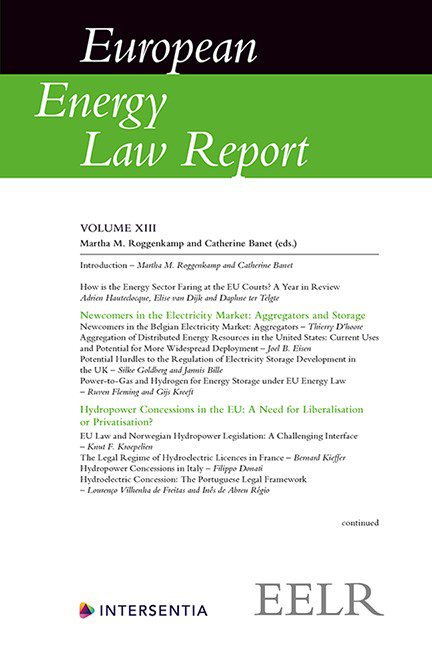Book contents
- Frontmatter
- Preface
- Contents
- List of Abbreviations
- List of Contributors
- Introduction
- Chapter I How is the Energy Sector Faring at the EU Courts? A Year in Review
- PART I NEWCOMERS IN THE ELECTRICITY MARKET: AGGREGATORS AND STORAGE
- PART II HYDROPOWER CONCESSIONS IN THE EU: A NEED FOR LIBERALISATION OR PRIVATISATION?
- PART III INVESTMENTS AND DISINVESTMENTS IN THE ENERGY SECTOR
- PART IV OFFSHORE DECOMMISSIONING IN THE NORTH SEA
- PART V CCS AS A CLIMATE TOOL: NORTH SEA PRACTICE
- PART VI FROM EU CLIMATE GOALS TO NATIONAL CLIMATE LAWS
Chapter VII - The Legal Regime of Hydroelectric Licences in France
Published online by Cambridge University Press: 30 April 2020
- Frontmatter
- Preface
- Contents
- List of Abbreviations
- List of Contributors
- Introduction
- Chapter I How is the Energy Sector Faring at the EU Courts? A Year in Review
- PART I NEWCOMERS IN THE ELECTRICITY MARKET: AGGREGATORS AND STORAGE
- PART II HYDROPOWER CONCESSIONS IN THE EU: A NEED FOR LIBERALISATION OR PRIVATISATION?
- PART III INVESTMENTS AND DISINVESTMENTS IN THE ENERGY SECTOR
- PART IV OFFSHORE DECOMMISSIONING IN THE NORTH SEA
- PART V CCS AS A CLIMATE TOOL: NORTH SEA PRACTICE
- PART VI FROM EU CLIMATE GOALS TO NATIONAL CLIMATE LAWS
Summary
INTRODUCTION
France has the second largest hydropower park in Europe (65 to 70 TWh per year), surpassed by Norway and followed by Sweden.
The French hydropower generation park also includes a number of small, sometimes very old, low-power installations, as well as plants such as Serre- Ponçon with a capacity of 1.3 billion m3 and an area of 28 km2 (the largest artificial lake in Europe). The hydroelectric facility of Grand-Maison, the most powerful, is capable of providing in just a few minutes the equivalent of the production of two nuclear units.
Hydropower accounts for 10–12 per cent of the national electricity generation in France and amounts to about 80 per cent of French renewable electricity production.
Today, the French hydropower park has about 2,500 power plants (comprising 400 licences). On average, the plants are about 50 years old. Licensed hydroelectric power generation (installations with an output exceeding 4500 kW) is divided between Electricité de France (EDF in the amount of 80 per cent) and the ENGIE Group (17 per cent). Independent producers hold the remaining licences.
After a long period of handling hydropower sectorally, the juridical framework regulating hydropower is now being increasingly integrated into the global framework of water resources law with a rationale of conciliation and usage sharing; on the one hand, to preserve resources in terms of water and biodiversity, and on the other hand, to develop renewable energies.
THE LEGAL FRAMEWORK FOR FRENCH HYDROELECTRICITY
Under the provisions of the Act of 16 October 1919 relating to the use of hydraulic power, only the French State may grant a right to use the driving power of rivers, lakes and tides: it establishes two entirely separate juridical regimes, depending on whether the gross maximum power of the facility is greater than 4,500 kW, or equal to or less than that value. The juridical regime is based on licensing in the first case and on permits in the second.
Prior to this landmark law in 1919, legislation on the water usage was based on both the civil code and the Act of 8 April 1898 relating to water resource management.
- Type
- Chapter
- Information
- European Energy Law Report XIII , pp. 153 - 164Publisher: IntersentiaPrint publication year: 2020

